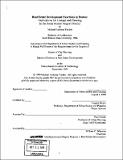| dc.contributor.advisor | Langley Keyes. | en_US |
| dc.contributor.author | Fischer, Michael Anthony | en_US |
| dc.contributor.other | Massachusetts Institute of Technology. Dept. of Urban Studies and Planning. | en_US |
| dc.coverage.spatial | n-us-ma | en_US |
| dc.date.accessioned | 2008-11-07T20:16:48Z | |
| dc.date.available | 2008-11-07T20:16:48Z | |
| dc.date.copyright | 1999 | en_US |
| dc.date.issued | 1999 | en_US |
| dc.identifier.uri | http://hdl.handle.net/1721.1/43603 | |
| dc.description | Thesis (S.M. and M.C.P.)--Massachusetts Institute of Technology, Dept. of Urban Studies and Planning, 1999. | en_US |
| dc.description | Includes bibliographical references (leaves 116-120). | en_US |
| dc.description.abstract | After several years of planning, Mayor Thomas Menino, the Boston Redevelopment Authority (BRA), and the Boston Real Estate Development community are poised to begin the build-out of the South Boston Seaport district. This area is considered by some, the most desirable urban property in the country, with estimates of 20 million square feet of buildings and nearly 44,000 new jobs to be created in the next 30 years. The only thing standing in their way is the politically powerful South Boston community. The people of South Boston are not necessarily against the development of the Seaport, but after almost 200 years of feeling abused by the business interests in Boston, they are going to exact a high price, and it will come in the form of linkage. On March 11, 1998, the BRA signed a Memorandum of Understanding with three South Boston leaders, paving the way for City Council approval of a new Convention Center in the South Boston Seaport. By taking advantage of good timing and influential leaders, the South Boston community managed to wrestle away at least half of the linkage money from the Seaport into the newly formed South Boston Betterment Trust. In addition, the South Boston community gained significant control over building heights in the Seaport, which will have a lasting impact on the aesthetic and economic future of the City. This thesis will review the 16 year history of Real Estate development linkage in Boston, particularly the way it has been leveraged to create affordable housing, in order to learn what is legal, what is appropriate, and what is currently happening with the linkage program in Boston. I will focus most of my attention on the Neighborhood Housing Trust (NHT) as the current vehicle for awarding linkage payments to the neighborhoods, and evaluate the impact of the new South Boston Betterment Trust (SBBT) on the planning process. I will conclude with recommendations for how the City and the South Boston Community can best utilize these Trusts to move the planning process forward in the South Boston Seaport District. With over $66 million in linkage expected from the Seaport development over the next three decades, it will be imperative for the South Boston community and the City that linkage money be spent wisely, to provide affordable housing for its citizens, and ensure the future of the linkage program for the City of Boston. | en_US |
| dc.description.statementofresponsibility | by Michale Anthony Fischer. | en_US |
| dc.format.extent | 120 leaves | en_US |
| dc.language.iso | eng | en_US |
| dc.publisher | Massachusetts Institute of Technology | en_US |
| dc.rights | M.I.T. theses are protected by
copyright. They may be viewed from this source for any purpose, but
reproduction or distribution in any format is prohibited without written
permission. See provided URL for inquiries about permission. | en_US |
| dc.rights.uri | http://dspace.mit.edu/handle/1721.1/7582 | en_US |
| dc.subject | Urban Studies and Planning. | en_US |
| dc.title | Real estate development exactions in Boston : implications for linkage and planning in the South Boston Seaport District | en_US |
| dc.type | Thesis | en_US |
| dc.description.degree | S.M.and M.C.P. | en_US |
| dc.contributor.department | Massachusetts Institute of Technology. Department of Urban Studies and Planning | |
| dc.identifier.oclc | 44890735 | en_US |
